HD250 Linear II
back to Sennheiser
back to measurements
home
published: Jul-12-2017, updated Sept-22-2023
NO SMOOTHING is applied to the shown plots. Most measurement sites have some smoothing applied which ‘irons flat’ sharp peaks and ‘wiggles’. I do not use smoothing because some info about sound quality is lost when plots are smoothed.
Aside from a small correction of the microphone itself also some correction in the lowest frequencies is applied to the plots to compensate for the perceived loss of bass when using headphones. This is described HERE in more detail.
A ‘horizontal‘ frequency response curve on the shown frequency response plots on this website thus indicates a perceived ‘flat’ tonal signature.
ALL measurements are made with a good SEAL on a flatbed measurement rig.
The shape of your head, bone structure, pad size, pad ‘softness, (compliance), hair or no hair and or wearing glasses may (drastically) change the frequency response of some headphones, so… your personal experience may differ substantially from these plots.
Frequency response (tonal balance) is the most sound-determining aspect of headphones. A horizontal line shows audible neutral response in the plots on this website. Deviations in different severity at different frequency bands have an effect on the sound character.
The bigger the deviation the stronger the effect.
Below an aid to help determining the sound character of headphones with relation to the frequency response.

Sennheiser HD250 Linear II

The Sennheiser HD250 Linear II is a closed over-ear dynamic headphone. It is a quite old headphone (from around 2001) already but when you can find one second hand in good condition for not too much you get a closed ‘fun’ headphone that sounds surprisingly ‘open’ with deep bass and fierce treble. Isolation is quite good.
The headphone is comfortable and lightweight with a low clamping force.
The pleather pads may become somewhat ‘sweaty’ on longer listening sessions but sadly are no longer available as spares.
One would have to resort to after-market pads which is a lottery when it concerns the audio quality.
The cable can be changed and has the familiar 2-pin Sennheiser connector. The cable is quite long (3m) and slightly microphonic.
The foam in the headband will probably be gone in most HD250 headphones.
The HD250-Linear II is not very sensitive and high impedance (280Ω) so requires an amplifier. It won’t play loud directly from a phone/tablet.
specifications:
Type: Over ear, closed
Usage: Home
Driver type: dynamic
Pads: replaceable pleather
Foldable: No
Headphone cup connector: 2 pin Sennheiser connector
Cable entry: dual sided
Cable: 3m long nickel-plated 3.5mm TRS plug + 6.3mm adapter to 2x Sennheiser plug
Driver size: 38mm
Max power rating: 0.2W
Max. Voltage: 7.5V (22Vpp)
Max. current: 27mA
Max. S.P.L.: 121dB
Impedance: 280 Ω (measured)
Efficiency: 99dB @ 1mW
Sensitivity: 104dB @ 1V
Weight: 215g. cable ads 60 gr.
Clamping force: low
Accessories: 6.3mm TRS adapter
Sound description:
Big bass… Not necessarily the type of bass that bassheads are looking for though. It goes deep but is not ‘detailed’ or ‘tight’. The bass is somewhat dis-attached from the mids. I prefer that over bloated bass myself. The mids are realistic and clear. Even though the bass and treble are considerably boosted the mids don’t sound recessed.
Open, forward with good clarity/presence and are ‘open’ and ‘dynamic’.
Then there is the treble. When you are coming from Grado or Beyerdynamic headphones ou may not find the treble objectionable. When you are used to more neutral headphones the treble can be harsh and grating with a lot of recordings. It does give the impression of being extremely detailed because of it. But in the end… it’s just boosted upper treble and not real fine nuanced treble.
Not really suited for portable usage unless you have an amplifier or only want to play music softly.
Measurements:
Below the frequency response of the HD250-II (left, right)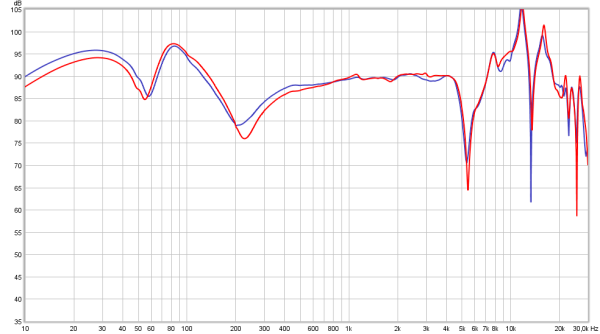 This tells the story and shows perfectly what is heard. Big bass (+10dB). The dip around 200Hz ‘disconnects’ the bass from the mids. Those mids are very realistic and as ‘neutral’ as can be. From 300Hz to 4.5kHz it is impressively flat. The treble area is about +10dB opposite the mids. This is quite a lot and very audible. At around 11kHz +15dB is reached !
This tells the story and shows perfectly what is heard. Big bass (+10dB). The dip around 200Hz ‘disconnects’ the bass from the mids. Those mids are very realistic and as ‘neutral’ as can be. From 300Hz to 4.5kHz it is impressively flat. The treble area is about +10dB opposite the mids. This is quite a lot and very audible. At around 11kHz +15dB is reached !
seal
Seal can be an issue with closed-back headphones. Breaking the seal (improper fit on the head) usually means a loss of (sub)bass. Seal breakage can be caused by different facial contours, glasses or hair between pads and head.
Below the effect of different levels of seal breach are shown .
Perfect seal, Seal broken by glasses with arms resting against the skin, seal broken by glasses with arms not resting against the skin.
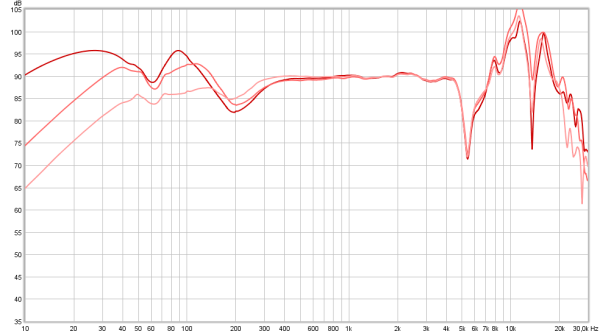 Breaking the seal changes the bass response considerably so depending on how good the seal is the bass levels may range from a bit bass-lite to quite bassy.
Breaking the seal changes the bass response considerably so depending on how good the seal is the bass levels may range from a bit bass-lite to quite bassy.
output resistance / damping-factor
As this is a dynamic headphone the frequency response might be amplifier output resistance dependent when certain higher output resistance amplifiers are used.
To test this the headphone is measured via an amplifier with output resistances of 0.2Ω, at 10Ω, 32Ω 120Ω. These traces are overlaid so tonal balance changes can easily be seen. On a higher output resistance amplifier the output level will be lower as well. The level drops 3.1dB at 120Ω.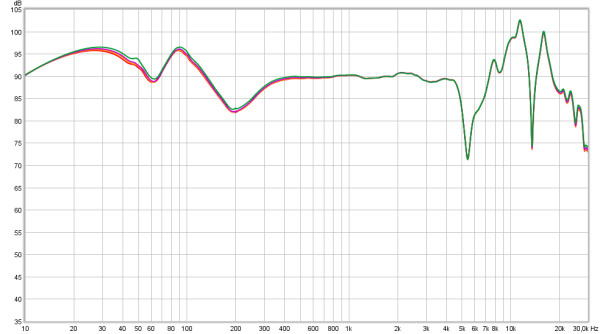 The tonal balance changes just slightly when connected to a higher output resistance amplifier. You get about 0.5dB more bass. This will not be audible so it is no problem to drive this headphone from amplifiers with a higher output resistance such as integrated amps, AVR and some tube amps.
The tonal balance changes just slightly when connected to a higher output resistance amplifier. You get about 0.5dB more bass. This will not be audible so it is no problem to drive this headphone from amplifiers with a higher output resistance such as integrated amps, AVR and some tube amps.
Below the distortion plots of the HD250-II at 85dB @1kHz.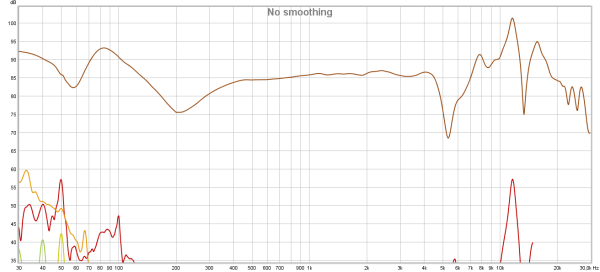
The plot above is in a dB scale, below the same measurement but in a percentage scale.
The distortion profile is quite typical for a dynamic driver. Higher 2nd harmonic distortion in the bass. The higher 3rd harmonic distortion below 70Hz points to some compression.
NOTE: The actual 2nd harmonic distortion above 100Hz may well be much lower than 0.2%.
A shortcoming (measurement limit) of my test fixture.
time domain measurements
Below the phase response of the HD440-II (left, right) Slow phase shifts are not very audible. Sharp changes in a narrow frequency bands may well be audible. There are such a sharp shifts present around 50Hz, 80Hz, 220Hz and above 4kHz.
Slow phase shifts are not very audible. Sharp changes in a narrow frequency bands may well be audible. There are such a sharp shifts present around 50Hz, 80Hz, 220Hz and above 4kHz.
The steep phase changes above 4kHz is another indicator for lesser treble quality.
Below the Group Delay which can also show potential problem areas. (left, right)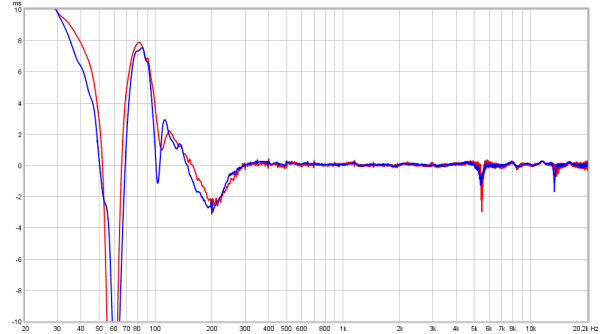
There is considerable ‘pad bounce’ around 60Hz. Also at 200Hz and 5.5kHz there are some deviations that indicate a resonance.
Below the CSD of the HD250-II (left and right channel are superimposed) Some ringing is visible at 8kHz and 11kHz as well as 17kHz. This driver has some damping issues above 6kHz.
Some ringing is visible at 8kHz and 11kHz as well as 17kHz. This driver has some damping issues above 6kHz.
Another form of looking in the time domain is the spectrum plot. The amplitude is color coded and both the time scale and frequency scale differ as well. Below the spectrum plot of the HD250-II (left channel)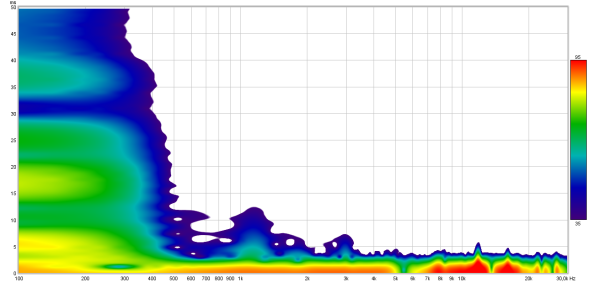
Some small lingering around 1.2kHz and 3kHz but these are not sound degrading. Otherwise this looks pretty decent. Bass does linger on a bit longer than desirable and may also be responsible for the somewhat ‘fatty’ bass.
Below a step response plot of the HD250-II (left, right) The step response clearly shows the ringing. This ringing is evidence of poor damping and simply is too high in amplitude and rings on way too long. The bassy character is shown by the somewhat lower initial rise of the signal and the +5dB hump afterwards.
The step response clearly shows the ringing. This ringing is evidence of poor damping and simply is too high in amplitude and rings on way too long. The bassy character is shown by the somewhat lower initial rise of the signal and the +5dB hump afterwards.
2nd HD250-Linear-II
Below the frequency response of the HD250-II (left, right)

This one seems older and needed some T.L.C. to say the least. The one above has grey plastic rings around the pads, this one has aluminium rings.
This is how it looks like after a revision (with after-market pads).

The original pads are pleather. This is a thin layer of vinyl on some cloth. The vinyl tends to tear and come off from the cloth after many years. The more it is used the quicker it decays.
Below a picture of the original pads it came with.
 Sadly the original pads are no longer available so one is left to look for suitable after-market pads.
Sadly the original pads are no longer available so one is left to look for suitable after-market pads.
modification and repair
The HD250 linear II in the review had issues with the cable connector contacts. This happens to all Sennheiser headphones from that time period.
The problem lies in the springs which widen at the spot where the cable pins are when inserted in the headphone (the far right side is where the connector plugs into) for one or more decades.
The trick is to bend the springs back into the original state as shown below. This can be done by using 2 small jewelers screwdrivers and some bending actions. do NOT remove the springs and make sure the straight part does not move while bending either. The driver wires are soldered onto the springs and very fragile.
When bent so that the coil windings are closer together again in the middle of the spring the contact will be fine again and will last for a decade again before the same issue pops up again.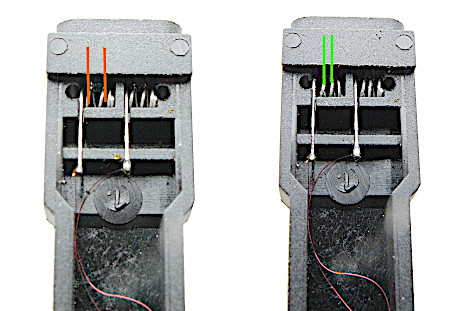 This HD250 linear II still had decent pads. The vinyl had come off from the cloth but has not been torn/damaged. The foam, surprisingly, also still was firm.
This HD250 linear II still had decent pads. The vinyl had come off from the cloth but has not been torn/damaged. The foam, surprisingly, also still was firm.
The foam that is supposed to be in front of the driver had completely fallen apart (becomes a sticky mess) and also has to be replaced. It has a double function. It covers the driver and ensures some distance between the pads and the ‘ports’ around the driver.
Measurements of the modified version:
The pads do need to be replaced though. Testing with several pads resulted in finding a velour pad that had the right acoustic properties and was suitable as an even more comfortable replacement.
As the shape of the pads at the driver side differs and the pad has an integrated cloth dust filter the foam is not needed.
All that needed to be addressed was the treble peak.
Experiments with toilet-paper revealed that 2 plies of a sheet of 3-ply toilet paper was enough to tame the substantial treble peak. The paper is cut to the same size as the original foam disc.
Below measurements of the original headphone (without the foam disc) versus the modified version (2 plies of toilet paper + velour pads).
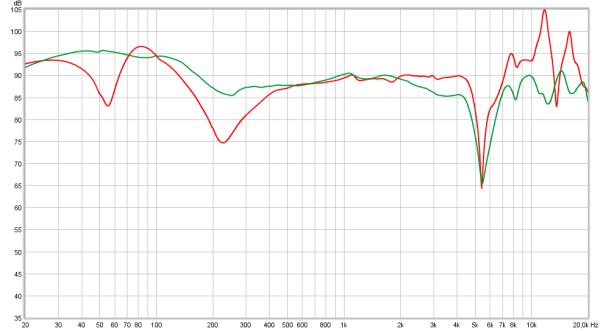 As can be seen the bass response improved, the dip around 200Hz is gone, the brightness (2-4kHz) is lowered a bit and the +15dB treble peak is gone.
As can be seen the bass response improved, the dip around 200Hz is gone, the brightness (2-4kHz) is lowered a bit and the +15dB treble peak is gone.
This has become a much better sounding headphone with no sharpness and smooth detailed treble.
(note: frequency response 20Hz-20kHz)
Below the difference in impulse response: modified, stock.
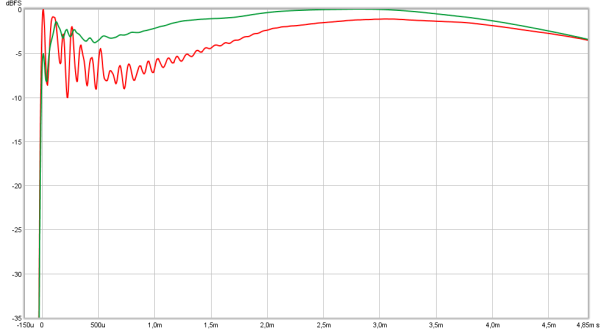
and below the CSD modified, stock.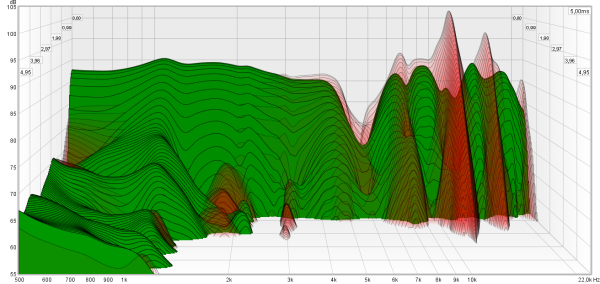
The resonances are completely damped and treble response is excellent.
This modified (and repaired) HD250-linear II is for sale.
summary
This headphone is great for those that like impressive bass and like heavily over-accentuated cymbals and isn’t afraid of feisty treble. The mids and overall sound is excellent. So is the comfort. When you can find one of these 2nd hand in good condition (headband and pads and connectors not making intermittent contact) and don’t have to pay absurd prices this headphone is a fun and comfortable headphone to own.
Fortunately the feisty treble can be reduced to a higher quality treble by replacing the foam discs in front of the driver with 2 plies of toilet-paper and some new (suitable) pads.
The headphone is quite comfortable as it is lightweight.
Quite suited for home usage and when driven from an amplifier that can supply a reasonable voltage.